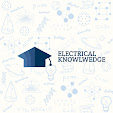CONDUCTOR, INSULATOR AND SEMI-CONDUCTOR
CONDUCTORS,INSULATORS, SEMICONDUCTOR
Conductors
In some materials, electrons move easily from atom to
atom. In others, the electrons move with difficulty. And in some materials, it
is almost impossible to get them to move. An electrical conductor is a substance in which the electrons are mobile.
The best conductor at room temperature is pure
elemental silver. Copper and aluminum are also excellent electrical conductors.
Iron, steel, and various other metals are fair to good conductors of electricity.
In most electrical circuits and systems, copper or
aluminum wire is used. Silver is impractical because of its high cost.
Some liquids are good electrical conductors. Mercury
is one example. Saltwater is a fair conductor. Gases are, in general, poor conductors
of electricity. This is because the atoms or
molecules are usually too far apart to allow a free
exchange of electrons. But if gas becomes ionized, it is a fair conductor of
electricity.
Electrons in a conductor do not move in a steady
stream, like molecules of water through a garden hose. Instead, they are passed
from one atom to another right next to it. This happens to countless atoms all
the time. As a result, literally trillions of electrons pass a given point each
second in a typical electrical circuit.
You might imagine a long line of people, each one
constantly passing a ball to the neighbor on the right. If there are plenty of
balls all along the line, and if everyone keeps passing balls along as they
come, the result will be a steady stream of balls moving along the line. This
represents a good conductor.
If the people become tired or lazy and do not feel much like passing the balls along, the rate of flow will decrease. The conductor is no longer very good.
Insulators
If the people refuse to pass balls along the line in
the previous example, the line represents an electrical insulator. Such substances prevent electrical currents from
flowing, Except possibly in very small amounts.
Most gases are good electrical insulators. Glass, dry
wood, paper, and plastics are other examples. Pure water is a good electrical
insulator, although it conducts some current with even the slightest impurity.
Metal oxides can be good insulators, even though the metal in pure form is a
good conductor.
Electrical insulators can be forced to carry current. Ionization can take place; when electrons are stripped away from their atoms, they have no choice but to move along. Sometimes an insulating material gets charred, or melts down, or gets perforated by a spark. Then its insulating properties are lost, and some electrons flow.
An insulating material is sometimes called a dielectric. This term arises from the fact that it keeps electrical charges apart, preventing the flow of electrons that would equalize a charge difference between two places. Excellent insulating materials can be used to advantage in certain electrical components such as capacitors, where it is important that electrons do not flow. Porcelain or glass can be used in electrical systems to keep short circuits from occurring.
These devices, called insulators, come in various shapes and sizes for different applications. You can see them on high-voltage utility poles and towers. They hold the wire up without running the risk of a short circuit with the tower or a slow discharge through a wet wooden pole.
SEMICONDUCTOR
In a semiconductor,
electrons flow,
but not as well as they do in a conductor. You might imagine the people in the
line being lazy and not too eager to pass the balls along. Some semiconductors
carry electrons almost as well as good electrical conductors like copper or
aluminum; others are almost as bad as insulating materials. The people might be
just a little sluggish, or they might be almost asleep.
Semiconductors are not exactly the same as resistors.
In a semiconductor, the material is treated so that it has very special
properties.
The semiconductors include certain substances, such as silicon, selenium, or gallium, that have been “doped” by the addition of impurities like indium or antimony. Perhaps you have heard of such things as gallium arsenide, metal oxides, or silicon rectifiers. Electrical conduction in these materials is always a result of the motion of electrons. However, this can be a quite peculiar movement, and sometimes engineers speak of the movement of holes rather than electrons. A hole is a shortage of an electron—you might think of it as a positive ion—and it moves along in a direction opposite to the flow of electrons.
When most of the charge carriers are electrons, the semiconductor is called N-type, because electrons are
negatively charged. When most of the charge carriers are holes, the
semiconducting material is known as P-type
because holes have a positive electric charge. But P-type material does pass
some ELECTRONS and N-type material carries some holes. In a semiconductor, the
more abundant type of charge carrier is called the majority carrier. The less abundant kind is known as the minority carrier.
Semiconductors are used in diodes, transistors, and
integrated circuits in almost limitless variety. These substances are what make
it possible for you to have a computer in a briefcase. That notebook computer,
if it used vacuum tubes, would occupy a skyscraper, because it has billions of
electronic components. It would also need its own power plant and would cost
thousands of dollars in electric bills every day. But the circuits are etched
microscopically onto semiconducting wafers, greatly reducing the size and power
requirements.


No comments:
If you have any doubts, please let me know